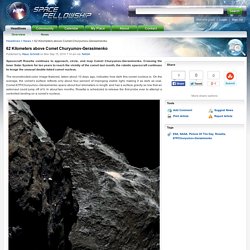

Philae couché sur le flanc sur la comète 67P. Rosetta’s Comet Really “Blows Up” in Latest Images. Jet activity on Comet 67P/C-G imaged on Jan. 31 and Feb. 3, 2015.

Credits: ESA/Rosetta/NAVCAM – CC BY-SA IGO 3.0. Edit by Jason Major. Paxi - Rosetta and comets. Where is Rosetta? The movie. As the incredible year of 2014 draws to a close, we have prepared a small treat for all of the readers of this blog who have followed Rosetta's progress over the months, in particular those who like to download images and play with them.

We started our CometWatch in July, when Rosetta was still a few thousand kilometres away from Comet 67P/Churyumov-Gerasimenko. We saw this curiously-shaped comet grow larger and richer in details as the spacecraft got closer and closer until rendezvous at 100 km on 6 August. The NAVCAM images released over that period provided a good overview of our approach to this amazing new world. In September, as we drew closer to the comet, we had to switch to taking four-image mosaics in order to ensure that we could cover enough of it for navigation purposes. Since then, we have been publishing some of these four-image sets as montages and mosaics, as well as releasing the individual frames so that you could work with them and create your own mosaics. Preparing for #CometLanding (French) ESA - Maquette Rosetta en papier. Did Philae drill the comet? Philae’s Sampling, Drilling and Distribution (SD2) subsystem was activated towards the end of the surface operations that Philae performed on Comet 67P/Churyumov-Gerasimenko last week, despite fears that it might alter the lander’s precarious position following its third touchdown.

Here we present the latest update from the SD2 team. SD2’s goal was to drill into the comet surface in order to collect and deliver samples to the COSAC and Ptolemy instruments inside the lander (Click here for our introductory post on SD2). It was the last of the lander’s ten instruments to be operated. @Philae2014 tweeted that the drill was activated as planned SD2 principal investigator Amalia Finzi has reported that the drill was deployed as planned, extending 46.9 cm below the balcony of the lander and 56.0 cm from its reference point. But other instruments on board Philae can help understand what actually happened. 62 Kilometers above Comet Churyumov-Gerasimenko.
Spacecraft Rosetta continues to approach, circle, and map Comet Churyumov-Gerasimenko.

Crossing the inner Solar System for ten years to reach the vicinity of the comet last month, the robotic spacecraft continues to image the unusual double-lobed comet nucleus. The reconstructed-color image featured, taken about 10 days ago, indicates how dark this comet nucleus is. On the average, the comet’s surface reflects only about four percent of impinging visible light, making it as dark as coal. Comet 67P/Churyumov–Gerasimenko spans about four kilometers in length and has a surface gravity so low that an astronaut could jump off of it. In about two months, Rosetta is scheduled to release the first probe ever to attempt a controlled landing on a comet’s nucleus. Rosetta: Rises and shines. Photo by ESA European Space Agency engineers and scientists hung nervously over their monitors, awaiting a feeble radio signal from a space voyager over 800 million kilometers (500 million miles) away.
As the minutes dragged on, the tension in the Space Operations Centre was palpable. All over the world, people on Twitter and other social media typed out words of encouragement … Phil Plait writes Slate’s Bad Astronomy blog and is an astronomer, public speaker, science evangelizer, and author of Death from the Skies! Follow him on Twitter. Follow … and then a thin, straight spike appeared among the noise of the cosmos. Rosetta is an ambitious mission: It will rendezvous with a comet, follow it through space around the Sun, and even send down a lander to the surface of the icy dirtball. Distant Horizons graphic updated by Michiel Straathof. Philae va bien et pourrait même vivre plus longtemps que prévu ! Attention !

Ne croyez pas tout ce qui est écrit. Autant la couverture médiatique sur Philae le jour de l’atterrissage était aussi précise qu’impressionnante, autant elle est aujourd’hui imprécise et à la limite du sensationnalisme budgétaire dépressif. How Harrowing Comet Landing by Philae Nearly Failed (Infographic) On Nov. 12, 2014, the European Space Agency's Philae lander touched down on the surface of the Comet 67P/Churyumov-Gerasimenko.

But the epic space feat — the culmination of ESA's Rosetta comet-chasing mission — could have ended in failure. Main Story: European Spacecraft Lands on Comet in Historic Space Feat When mechanisms intended to secure Philae to the surface of Comet 67P failed, the lander bounced back into space twice before settling to rest in partial darkness at the foot of an icy cliff. Rosetta Mission's Historic Comet Landing: Full Coverage The action took place 317 million miles (510 million kilometers) from Earth and 14 miles (22.5 km) from the comet, Rosetta released the lander. Philae hit the surface at 3.3 feet per second (1 meter per second). Comète 67P : les 5 sites présélectionnés pour l’atterrissage de Philae. Le week-end dernier au CNES à Toulouse, plusieurs dizaines de responsables scientifiques de la mission Rosetta ont retenu 5 sites apparemment viables pour la tentative d’atterrissage du module Philae en novembre prochain.

Plusieurs images du noyau de la comète 67P Churyumov-Gerasimenko sont nécessaires pour montrer la position des 5 sites d’atterrissage qui ont été sélectionnés ce week-end par les scientifiques de la mission Rosetta.Crédits : ESA/Rosetta/MPS for OSIRIS Team MPS/UPD/LAM/IAA/SSO/INTA/UPM/DASP/IDA La sonde Rosetta se rapproche peu à peu du noyau de la comète 67P Churyumov-Gerasimenko. Elle manœuvre actuellement à une cinquantaine de kilomètres de la surface et ses instruments poursuivent leurs observations pour aider les scientifiques à choisir le site d’atterrissage du module Philae en novembre prochain. The singing comet. Philae’s First Photos.